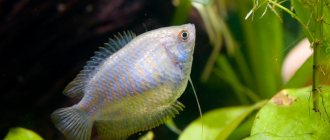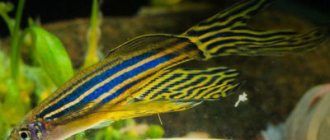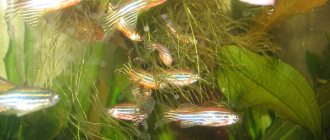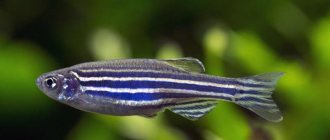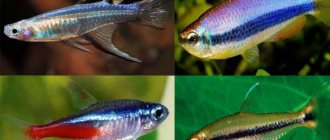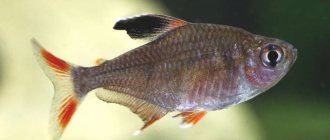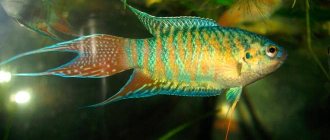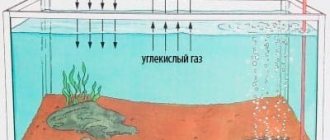Habitat
The historical homeland of this fish is considered to be India and Indochina, Asia. The pink zebrafish lives in cool freshwater bodies of water. In European countries, they learned about this fish at the beginning of the last century, and it soon gained immense popularity among aquarists around the world.
Today, the pink zebrafish is bred by breeders and is on the verge of extinction. Therefore, it can be found much more often in artificial reservoirs than in the natural environment.
Appearance Features
Appearance of pink zebrafish:
- Dimensions . In its natural habitat it can grow up to 8 cm. When grown in an artificial reservoir, the length of an adult does not exceed 4-5 cm.
- The body is elongated and elongated, slightly compressed from the sides.
- The head is small and proportional, in perfect harmony with the body. There is a pair of antennae above the upper lip of the fish, giving it a funny look.
- Fins . The dorsal and anal fins are quite long and have a veil-like shape and a yellow-green color. A distinct pink stripe runs through the anal fin. The caudal fin is single, often colored bright scarlet.
- Color. The color is dominated by pink in its various variations with a bluish tint. The abdomen shimmers in the light with all the colors of the rainbow, which looks very impressive. Along the sides of the body there are bright red stripes, which gradually fade with age. A characteristic feature of the fish is that it acquires its color as it grows older. Individuals that have not reached sexual maturity have unremarkable gray-blue scales.
Sexual dimorphism. You can distinguish a male from a female by size and color. Males have a slimmer build and rich, brightly colored scales. In addition, the fins of males are longer and more developed. In females, upon reaching sexual maturity, the abdomen is noticeably rounded.
How long do they live?
The average lifespan of pink zebrafish in an artificial pond is about 8 years.
However, according to experts, with proper care and favorable living conditions, it can live up to 10 years.
History of appearance, description of appearance, photo
Pink Danio (you can find the name Danio roseus) is a selective breed of small schooling fish from the carp family. This species does not exist under natural conditions, since it was bred artificially.
For quite a long time, breeders selected among Danio rerio those fish that had a pinkish skin color. Over time, the trait was fixed and became stable, after which the breed gained great popularity among aquarists.
Pink Danios have a small elongated body, the length of which reaches 4.5 cm. There is a pair of small antennae on the upper jaw.
These fish got their name due to the attractive bright pink color of their body.
Depending on the environment and viewing angle, the scales can shimmer and change their shade from pale pink to bluish-silver. Blue or lilac stripes are usually clearly visible on the sides.
Pink Danio fry are gray or pale blue in color. Their fins are most often yellow-green, with a bright purple-pink stripe running along the anal fin.
Classic Pink Danio
Veiled Pink Danio
Conditions of detention
Pink zebrafish is unpretentious in terms of keeping and does not require special attention. But in order for the fish to feel comfortable and look good, it is necessary to create optimal conditions for it:
- Dimensions and shape of the aquarium . Pink zebrafish is an active and mobile fish, so it needs a sufficient amount of free space to move. An ideal option for keeping would be an artificial rectangular pond with fairly high walls, with a volume of 50 liters or more (depending on the expected number of aquarium inhabitants). Since the zebrafish is very active and can jump out of the tank, resulting in death, it is necessary to use protective glass or a special lid.
- Water parameters : temperature – from +20 to +24°C; hardness – up to 20 dGh; acidity – from 6 to 7 units.
- Filtration is necessary as these fish require clean water. But you should not use too powerful devices, since the fish do not tolerate strong currents well.
- Aeration is important for maintaining the health of these ornamental fish, which require increased amounts of oxygen present in the aquatic environment.
- Vegetation . The presence of a sufficient amount of green space creates the most comfortable conditions for fish. The ideal choice would be crops such as cabomba, elodea, and vallisneria. Other long-stemmed greenery will also work. But when planting plants, you should not forget that there should be enough space in the aquarium for the free movement of fish. Therefore, it is recommended to plant aquatic and surface crops on the sides and near the rear walls of an artificial reservoir.
- Lighting . Bright lighting will highlight the natural beauty of this amazing fish, making it look like a flickering spark. Danio pink also needs natural light. Therefore, it is recommended to position the aquarium in such a way that it is exposed to ultraviolet radiation for at least 2-3 hours throughout the day.
- Decorating an aquarium . The best choice would be driftwood and ceramic decorative elements, which will not only create an impressive aquarium design, but also provide the fish with shelter in case of potential danger or for rest.
- Soil . Experts recommend using dark river sand or small pebbles as soil. Against a dark background, pink zebrafish will look most vibrant and impressive.
- Replacing water . The fluid in an artificial reservoir must be replaced once a week by approximately 30% of the total volume of water in the aquarium.
- Feeding. Pink zebrafish is an omnivorous fish, but most of the diet should consist of protein foods - frozen or live food. Bloodworms, brine shrimp or daphnia are perfect for these fish. Fish are prone to overeating, so they should be fed once a day, in small portions. It is important that the food does not settle to the bottom of the aquarium, since the zebrafish feeds only from the water surface. Remains of uneaten food must be removed immediately.
Caring for the fish is not difficult, which is why zebrafish are very popular not only among experienced aquarists, but also among beginners.
Maintenance and care
There is nothing difficult in breeding and keeping these charming fish at home. They do not require any particularly complex care. You will need an aquarium with a volume of about 50 liters. Danio rerio are quite unpretentious, but they love clean, fresh water. A comfortable water temperature for them is about 20 - 25° C. Higher temperatures are not dangerous for them, but are undesirable. In this case, the ripening of eggs occurs faster, and the risk of cyst diseases increases.
The water height required is 30 cm or more. Given the playfulness of these fish, the aquarium must be covered to prevent them from jumping out. It is imperative to ensure water filtration and aeration. They require acidity close to neutral (6.0 – 7.0 pH). And approximately once every 5 – 7 days, change at least 30% of the water.
Now about the lighting. It is recommended to install fluorescent lamps (preferably daylight) in front of the glass of the aquarium, and not on the sides or top. Thus, the refraction of oblique rays will provide the extraordinary beauty of the pearlescent shine of the scales of these fish. But we must not forget about natural sunlight. Therefore, the aquarium is installed so that the sun's rays fall on it for at least 3 hours a day.
You need to apply soil to the bottom of the aquarium: coarse sand or small pebbles. And also plant small-leaved aquatic plants, but not too densely, so that they do not interfere with the movements of these nimble and active fish.
How long do these charming creatures live? On average, their lifespan in an aquarium is 2 – 3 years.
Compatibility with other types
Pink danios are peaceful, calm, friendly fish that are perfect for keeping in a common artificial pond with other aquarium inhabitants. These fish lead a school life and feel extremely depressed when alone. Therefore, it is recommended to purchase 6-7 individuals at once.
Decorative fish will be ideal neighbors for pink zebrafish:
- tetra;
- neons;
- minors;
- corridors;
- thorns.
It is not recommended to keep pink zebrafish in the same aquarium with aggressive, large and predatory fish. These fish are absolutely incompatible with:
- cichlids;
- goldfish;
- swordtails;
- large catfish;
- barbs.
These fish also get along well with shellfish and shrimp. They are not prone to aggression even during the breeding season. Therefore, when choosing neighbors, you should only think about ensuring that other aquarium inhabitants do not harm the pink danios themselves - fragile and defenseless creatures.
Maintenance and care, arrangement of the aquarium
The recommended aquarium volume for long-term keeping of Pink Danios starts from 80 liters. The design is not critical; in pet stores, for example, they are kept in empty tanks and feel great. The only thing worth paying attention to is the availability of free space for swimming, so you should not overload the aquarium with design elements and/or allow it to become overgrown with aquatic plants. Despite the fact that conditions in nature are variable, when kept in an artificial environment, strong and sharp fluctuations in temperature and hydrochemical composition of water (pH / dGH) should not be allowed. Aquarium maintenance consists of several simple and standard procedures. The most important include: weekly replacement of part of the water with fresh water, regular removal of organic waste (feed residues, excrement), equipment maintenance, monitoring and maintaining stable values of water hardness and alkaline composition. Important! The fish tend to jump out, so it is recommended to use a lid.
Breeding and reproduction
Pink danios are distinguished by their ability to reproduce throughout the whole year. Moreover, this process does not require much effort from the aquarist. It is enough just to create the most comfortable conditions for the fish during the spawning period.
Preparing for spawning. First of all, you need to select a couple of the strongest, healthiest and most attractive male and female fish. Determining readiness for reproduction is very simple. During this period, the color of males becomes brighter and more saturated, and the abdomen of females becomes rounded.
It is best to carry out breeding in a separate tank, especially if pink danios live in the same artificial reservoir with other aquarium inhabitants.
The average volume of the spawning tank should be about 40 liters.
The bottom of the tank should be covered with a special grid, and the aquarium itself should be decorated with a small amount of greenery.
Spawning . The spawning period in pink danios occurs exclusively in the morning. Males court females and then squeeze eggs out of them in a mating dance. This process takes about 2-3 hours. At one time, the female is capable of laying up to 2000 eggs. The eggs remain in the net lying at the bottom of the spawning tank.
Immediately after spawning, adult individuals are moved to a common artificial reservoir, the eggs are carefully shaken off, the net is removed, and the water in the spawning tank is changed by 25-30% of the total volume. The fry are born within 5-6 days depending on the temperature.
Caring for offspring . Pink danios, despite their peaceful disposition, lack parental instincts, so care for the offspring falls on the shoulders of the aquarist. It is recommended to feed babies with ciliates and “live dust”, gradually switching to adult food. Pink zebrafish fry grow and develop very quickly.
When they reach watering maturity, which occurs between 4 months and six months, the fish can be moved to a common artificial reservoir.
Read the article:
- zebrafish;
- glowing fish in an aquarium.
Reproduction
One of the reasons for the popularity of pink danios is that breeding them is not difficult. Fish reproduction begins with the preparation of the spawning ground:
- Select a tank with a volume of 30-40 liters.
- Place soil about 2-3 cm high at the bottom.
- Stretch a fine mesh.
- Pour water that meets the following parameters: hardness - about 10dH, acidity - 7.0pH, temperature - 20-25°C.
The pair selected for breeding is seated in different containers for 10-14 days, fed with live food: daphnia, bloodworms, tubifex.
A rounded belly indicates the female’s readiness to spawn. In the evening, a male is placed in the spawning tank, and a few hours later a female is added, turning off the lights.
Veiled ones begin to spawn in the morning. Mating games consist of the male chasing the female and striking her abdomen in order to knock out and fertilize the eggs. The eggs settle to the bottom of the mesh. In an hour, the female is capable of laying about 200 eggs.
15:14
Danio breeding from A to Z
07:13
Zebrafish Spawning
02:59
INCUBATING ZANIO Caviar IN A THREE-LITER JAR, FROM Caviar TO FRY!
After the end of spawning, adults are removed. The net is shaken off and removed.
To avoid infection of the eggs, the water in the spawning area is disinfected with iodine (3-4 drops per 10 liters of liquid).
The fry appear on the 3rd day. The source of nutrition for them during the first days is their yolk sac.
After 6-7 days, the babies begin to swim in search of food. To feed young animals, use ready-made liquid food or mashed boiled egg yolk. After a week, the fry’s diet includes brine shrimp, rotifers, and beef heart. After 4 months, the young animals are transplanted into a common aquarium.
Possible diseases
The pink danio has good health and a strong immune system. However, poor-quality nutrition and a polluted water environment can provoke the development of a number of diseases:
- Flatulence . It is easy to notice by the bloating and passivity of the fish, which spends most of its time at the bottom of the aquarium. Treatment is carried out with the help of Trichopolum.
- Bug-eyes - occurs due to pollution of the aquatic environment. Lack of treatment leads to complete blindness. Therefore, you should clean the aquarium, disinfect it, and replace the water. If these measures do not help, then contact a veterinarian.
- Formation of growths . In this case, salt baths will help. It is necessary to dilute salt in warm water (at the rate of 1 tablespoon per 1 liter of liquid) and place the sick fish in a container with saline solution. The optimal time for the procedure is 15-20 minutes.
- Tuberculosis . It is a contagious disease, so at the first sign of it, sick individuals should be placed in a separate aquarium to avoid the spread of infection. Treatment is carried out using food with the addition of antibiotics. Only a doctor should determine medications and their dosage.
- Intoxication . Nitrate poisoning can manifest itself as restlessness and fish swimming in circles. In this case, it is necessary to completely replace the fluid in the artificial reservoir and change the water daily by 30% of the total volume for a week.
Pink Danio is a beautiful, graceful, peace-loving fish. The absence of a tendency to diseases, manifestations of aggression, and a peaceful attitude towards other inhabitants of an artificial reservoir have made this ornamental fish one of the most popular among aquarists.
Care and maintenance
Despite their unusual origins, Pink Danios have inherited their unpretentiousness from the Rerio.
Those aquarists who have already kept any breed of Danio can easily cope with caring for pink fish. Beginners should also not have any problems.
Requirements for an aquarium
Choosing an aquarium for Pink Danios and its design will not cause difficulties if you follow all the recommendations given.
Are common
It is believed that Danios are capable of living even in a three-liter jar, but such a colonization will be a real torment for the fish. They should be kept in a flock of 6 to 8 individuals, all of which need clean water and adequate swimming space. Thus, the recommended aquarium volume starts from 40-50 liters.
Since these fish love to chase each other, the shape of the aquarium should be oblong. You definitely need to put a lid or cover glass on top, as they often frolic and jump out of the water.
What plants can be used and are they needed?
Pink Danios need to be allowed to move freely around the tank so that plants do not interfere with their movements. In principle, you can do without plants, but if you still want to arrange green spaces, then you should choose plants with long stems and small leaves. So, elodea or cabomba are good options and should be planted near the walls of the aquarium.
What soil is the best?
Any bottom soil will do, for example gravel or coarse sand would be a good option.
It is important to pre-heat the soil in the oven or rinse it in boiling water so as not to introduce an infection into the aquarium.
Necessary equipment
Be sure to install a filter and aerator. Some sources indicate that Pink Danios can get by without the extra equipment, but in reality this will result in an increased risk of disease. In addition, they love running water, which can be created using a filter.
What kind of lighting should there be?
Fish need lighting, which is at least 10-12 hours a day, so they cannot do without an additional light source.
Lighting also has a decorative function, since Pink Danios look most attractive in the light.
Water requirements
It is recommended to set the following chemical water parameters:
- hardness – 7-15°;
- acidity – 6.5-7.5 pH.
Danio rerio cannot be called heat-loving, and the pink species has inherited this feature, so the optimal temperature is approximately 21-25°C .
